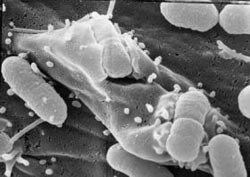Ability to develop new anti-bacterial drugs
Researchers at the Hebrew University in Jerusalem have achieved a breakthrough in controlling the dangerous pathogen's bacterial pathway system - a promising achievement that paves the way for a drug that could be invaluable. Effect of those pathogens.
Most bacteria are not harmful and do not infect. However, some cause disease and are equipped with special tools to transmit toxins (also known as 'infectious factors' ) into the infected person's cells.
Many bacteria cause disease, from food poisoning to dangerous infectious diseases, using nano-like organs (specialized parts of cells with specific functions) to inject toxin-transmitting factors into the host cell of the attacked. This process is called a Type 3 infection system (TTSS). One of these sources is Salmonella, bacteria that cause typhoid, Yersinia, and E. Coli intestinal diseases, which cause 1 million babies to die each year, mostly in developing countries.

Electron micrographs of bacteria (cylindrical objects) cling to host cells.These bacteria are in the process of injecting toxins into host cells.(Photo: Hebrew University)
The syringe used by the bacteria mentioned above is a potential target for drugs that are not currently on the market to combat the diseases they cause. However, in order to develop these drugs, a deeper understanding of the features of syringes is essential, as well as the development of more effective methods of controlling bacterial activity. .
Researchers at the Hebrew University - Ilan Rosenshine, professor Etta Rosensohn of bacteria from the Hebrew University School of Medicine, and colleagues - Erez Mills, Kobi Baruch, Xavier Charpentier and Simi Kobi - designed one. Real-time test method allows control of the operation of the syringe.
Applying the test method, they discovered new properties of the system, which can be used to develop pharmaceuticals that control the operation of syringes and thereby prevent plague and infection. germs caused by dangerous pathogens.
Their achievements were published in a recent article in the Cell Host & Microbe magazine.
- Clues to develop E.coli anti-bacterial vaccine
- Bacteria grow older?
- Develop drugs that kill many types of cancer
- Mechanism of resistance to many bacterial drugs
- NASA wants to use the old herbicide for the astronaut
- Cars 'sniffing' the world's first drug
- The truth about drugs that destroys even more terrifying bodies than
- Scientists 'fix' bacterial life trees
- New anti-bacterial material
- Antihypertensive drugs with ACE badly affect the fetus
- 'New weapon' against antimicrobial from synthetic sugar
- The best way to help children develop language skills
 Why do potatoes have eyes?
Why do potatoes have eyes? 'Tragedy' the world's largest carnivorous life: Death becomes ... public toilet
'Tragedy' the world's largest carnivorous life: Death becomes ... public toilet Tomatoes were once considered 'poisonous' for 200 years
Tomatoes were once considered 'poisonous' for 200 years Detecting microscopic parasites on human face
Detecting microscopic parasites on human face